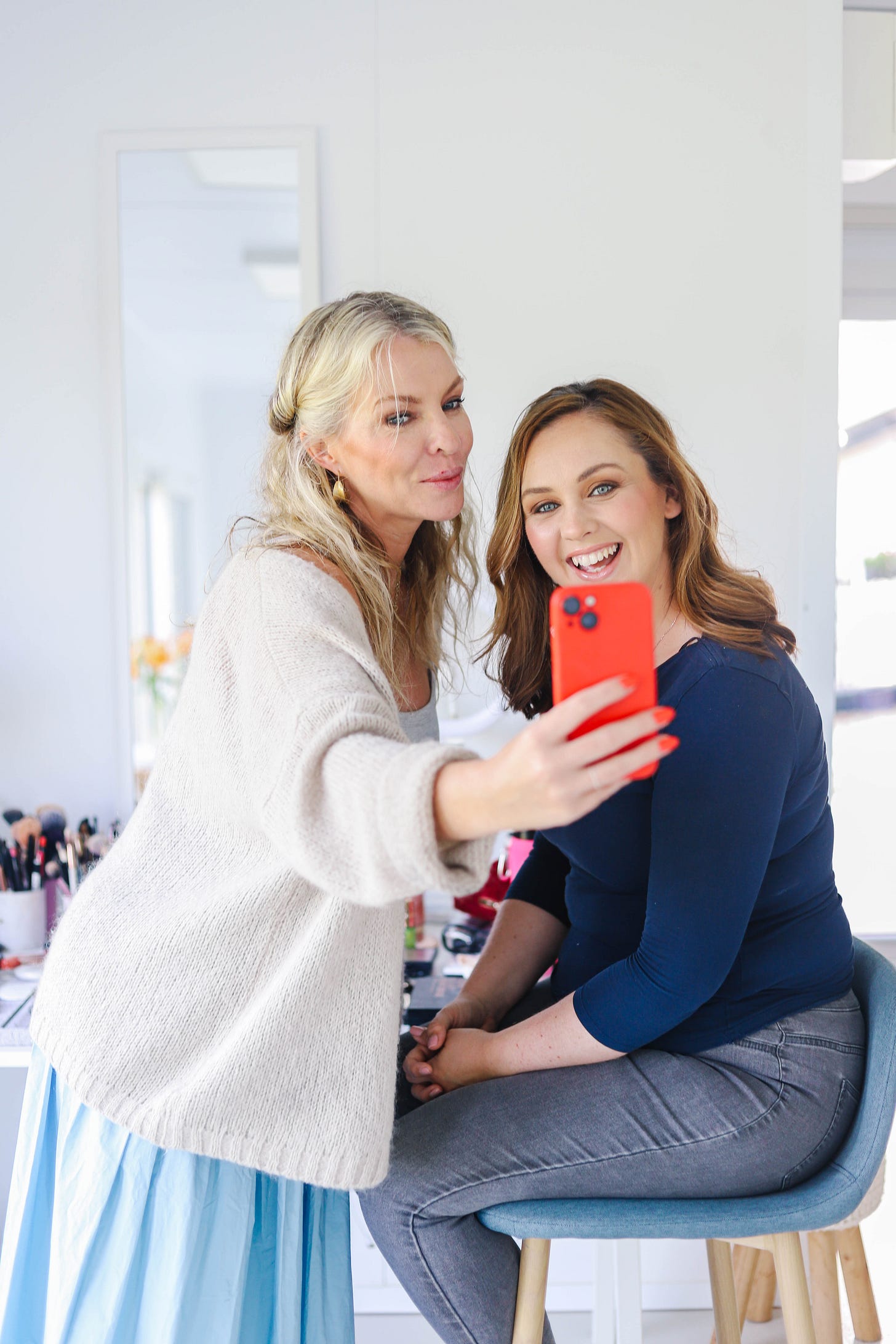How to stay anchored in self-trust when every post in your feed tells you you’re failing
Feeling triggered by online advice? Here’s what that gut punch is really telling you
In the last few weeks something has really hit me when I look at other people’s marketing and the weird little universe I spend my time in online.
Particularly as I lean into the realisation that the clients I work with want to trust themselves more, this realisation about a pervasive marketing tactic is even more important.
Because as solopreneurs all we want is to make business decisions with confidence and trust ourselves to navigate whatever comes next, no matter what.
The clients I work with are craving the exciting shifts and expansion that will come on the other side of operating from self-trust instead of fear and claiming bigger opportunities to create real momentum in their work.
But it’s no wonder this feels a struggle, when a predominant way we are marketed to is to tell us we’re wrong.
While writing this article I had a quick rummage for just 5 minutes and found some examples in my inbox and in my social feed. It wasn’t difficult:
Email: The biggest mistakes business owners make (and how to avoid them)
Instagram: Social media mistakes I see a lot of
Substack: The real reason your marketing isn’t working (and the surprisingly simple fix)
Hell, I even opened one social channel to be told Substack is just a shiny distraction and isn’t where I should be spending my time.
Wrong. Wrong. Wrong.
You are making mistakes. Messing it up. Missing the obvious things.
And look, I get it.
Telling someone about the mistakes they’re making is a powerful hook.
Humans don’t want to make mistakes. Solopreneurs like me sure as hell don’t want to be out here wasting our time on things that are going to be a drain on resources, or worse, be detrimental to us attracting clients.
So we click, we open, we scroll and we swipe when we’re told there’s a way to avoid getting it wrong.
We want to make sure we aren’t the idiots making these mistakes.
And as we consume, we question.
We question over and over.
Is that me?
Is that what I’m doing?
Am I the idiot here?
Am I falling into these traps?
Should I be doing it differently?
And can I just tell you (as if I need to), it’s relentless.
To open your inbox and feeds every day to be made to feel like you’re getting it wrong takes up a colossal amount of brain space and emotion.
It distracts from the plan, it pulls you from your goals and your focus, it undermines your decisions and the path you’ve set for yourself.
Now, I am aware as a Self-Belief Coach (and general enthusiast for a growth mindset) that I am fully in control of what I think and therefore what I feel.
I get to choose whether to interpret these emails, articles and social posts as indicators that I am, indeed, making a sh*t tonne of mistakes.
Which means I also get to choose whether to brush them off, delete, mute or scroll past, without letting the message bother or affect me. To see it and be able to think “that’s not for me.”
But.. Is it that easy? To train yourself to ignore this stuff?
Because I have also been fascinated with the conflict that is: are we thinking beings that feel, or feeling beings that think?
Which in this context means: do I choose what to think first, and the feelings follow? Or is the feeling an immediate and uncontrollable part, with the thought attached afterwards?
When I open an email that says “The real reason your marketing isn’t working”, do I think first, or feel first?
Do I read it and think “Oh cr*p, they think my marketing isn’t working, I’d better read this to make it better.” And then feel bad about myself and how I’m promoting myself as a result.
Or do I read it and have the sinking, kick in the gut feeling first just seeing the words, with the thought only attached afterwards that it makes me feel I’m doing my marketing wrong.
Maybe it’s just that when I’m not feeling resilient or full of self-trust or self-belief, it doesn’t matter massively which comes first. That the lasting impact, the ripple and the vibration left in my body, whichever way it comes about, is a negative one.
I’m left with a sense of inadequacy and insecurity. A loosening of my anchor that what I know inherently, who I am, how I’m choosing to market myself and what I’m focusing on, is going to pay off, and not to be distracted by every piece of content that crosses my screen.
Because let’s be honest, we do wobble!
We’re not always in sassy “I have a solid business plan thanks and this advice is not for me” mode.
There are gaps, there are weak spots, there are moments that protective voice finds a chink in the armour and grabs on to this sort of marketing as evidence that we are failing and doing it wrong.
So here are three things I’m doing to make sure that this sort of messaging doesn’t affect me (or you):
1. I’m using the idea of a bubble around me to protect me from messages not meant for me.
When I notice my nervous system reacting to a piece of content - whether that’s a pang of shame, a flicker of self-doubt, or a tightening in my chest - I imagine a kind of bubble around me. A soft, breathable, but intentional boundary that filters what gets in.
This bubble helps me say: “This message isn’t for me.” It’s a way of reclaiming my focus and trusting my own direction, rather than letting every loud opinion pierce through and shake my sense of self.
It’s something I’m borrowing from Psychotherapist Marci Carroll who taught it as a method to use when you receive unwanted and unsolicited parenting advice when you’ve just become a mum.
The bubble method can be used perfectly here too. Because the business advice, as well intentioned and ‘helpful’ as it’s trying to be, is just as difficult to deal with as something like “you shouldn’t still be breastfeeding at that age” is for a mum just trying to do her best, trust her instincts and choose the right supportive information and experts for her.
Because ditto when you’re a solopreneur.
2. I’m pausing to ask: what belief is this messaging trying to activate in me?
You know that phrase “It’s not ‘why is this happening to me?’ but ‘what is this teaching me?’”
I’m applying it here.
Instead of just scrolling past or muting out of irritation when I see someone pointing the finger in their marketing, I’m choosing to get curious.
When I feel that gut-punch from a “you’re doing it wrong” headline, I’m going to pause and ask: What part of me believes that’s true? What old story is this touching on?
I encourage my clients to be in dialogue with their ‘Safety Guardian’ – the protective part of them that tries to keep them small, safe and free from risk. By harnessing this conversation I can have with myself, this turns the moment into an opportunity.
Not to shame myself or spiral, but to notice which protective belief might be asking for attention, and whether I want to keep reinforcing it, or shift it.
3. I’m watching my own marketing and avoiding ‘mistakes’ and ‘you’re doing it wrong’ type angles in my messaging.
I want the solopreneurs reading my content to feel seen, not scrutinised. Inspired, not inadequate.
That doesn’t mean I won’t challenge or stretch people’s thinking. But I’ll never do it by making them feel like they’re broken or clueless.
The people I work with already have inner doubt - I’m not going to pile on.
Going forward I’m checking in with the energy behind my own words.
Am I building self-belief, or chipping away at it? That’s the filter I’m using now.
Feel free to call me out if you spot me slipping on this (whilst also knowing, you’re in control of how you react and what you see!).
I’d love to know what you think.
You can find out more about working with me here.
Join the Self-Belief Business Experiment
Get an inside look at my most personal journey yet.
The Self-Belief Business Experiment is a raw, honest exploration of rebuilding confidence and transforming my business from the inside out.
Sign up to follow along as I share real struggles, small wins, and the ups and downs of tackling my own self-doubt head-on.
This isn’t a polished success story—it’s a transparent look at what it truly takes to build a business backed by belief.




